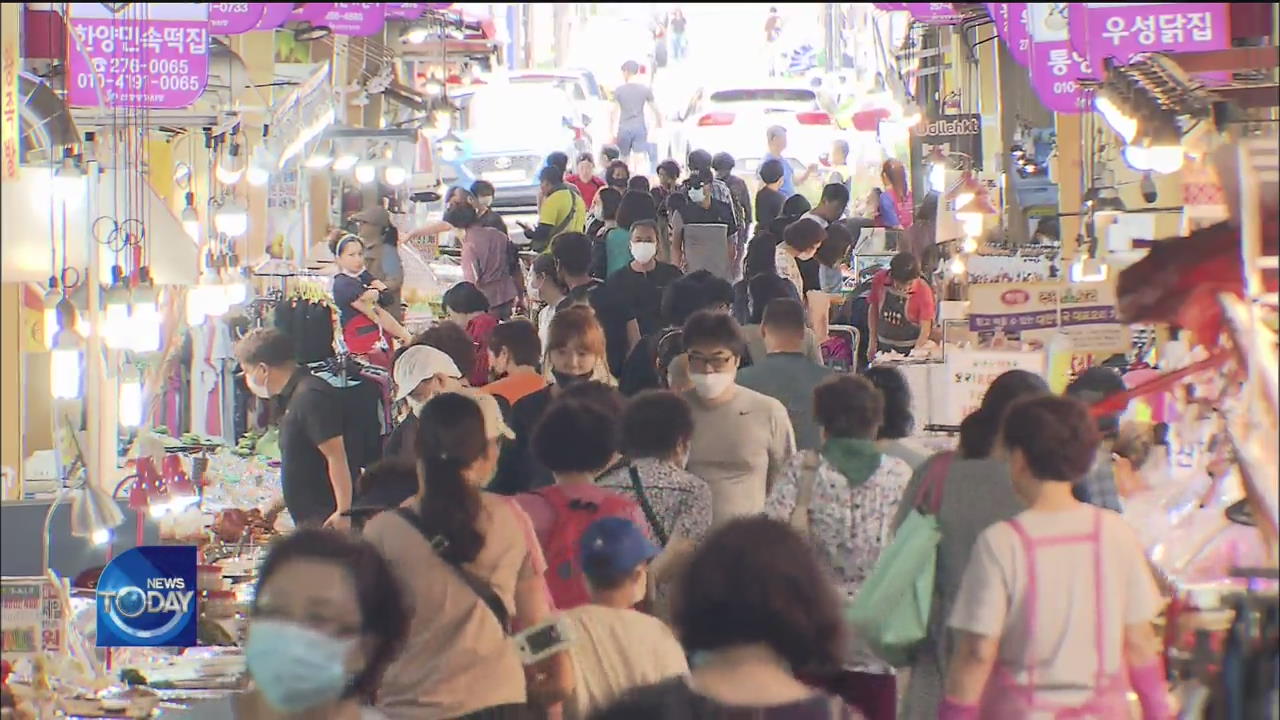LOCAL MARKETS STRUGGLE AMID RETAIL DIGITIZATION
입력 2020.07.06 (15:07)
수정 2020.07.06 (16:46)
읽어주기 기능은 크롬기반의
브라우저에서만 사용하실 수 있습니다.
[Anchor Lead]
COVID-19 has accelerated the digitization of the retail sector. Large retailers have increased their investments in online shopping and delivery services, but small businesses or traditional markets find it hard to catch up with the rapid change.
[Pkg]
Super sale! 50% off! Price knockdown signs are plastered all over the market. But it's not drawing too many shoppers. Disaster relief money has long lost its effect.
[Soundbite] KOH IL-DONG(MERCHANT, ULSAN SINJEONG MARKET) : "I saw our sales spike when people got their disaster relief money. But after a month, it was back to way things were."
Due to fears of COVID-19 infection, more consumers now shop online instead of visiting stores in person. Since the pandemic is expected to linger for a prolonged period, retailers are stepping up digitization to facilitate so-called 'untact' consumption where face-to-face contact is not necessary. Retail companies attempt various changes, including investing heavily to enable speedier delivery and "live commerce" which allows consumers to interact with sellers anytime, anywhere through live streaming on their smartphones. But traditional markets and small stores lack capital for such extensive changes.
[Soundbite] SOHN BYEONG-GIL(CHAIR, ULSAN SINJEONG MARKET MERCHANTS' ASSOCIATION) : "We know online shopping is the way to go, but traditional markets don't have adequate online infrastructure and we merchants lack IT knowledge."
Some express concerns traditional markets could go extinct if the current situation drags out.
[Soundbite] LEE GYEONG-WOO(ULSAN RESEARCH INSTITUTE) : "Once traditional markets have digitized sales and distribution channels, they will be capable of retaining their positive functions and respond to new spending patterns."
It's imperative that all sides work together in formulating ways to help such businesses evolve and survive the post-pandemic world.
COVID-19 has accelerated the digitization of the retail sector. Large retailers have increased their investments in online shopping and delivery services, but small businesses or traditional markets find it hard to catch up with the rapid change.
[Pkg]
Super sale! 50% off! Price knockdown signs are plastered all over the market. But it's not drawing too many shoppers. Disaster relief money has long lost its effect.
[Soundbite] KOH IL-DONG(MERCHANT, ULSAN SINJEONG MARKET) : "I saw our sales spike when people got their disaster relief money. But after a month, it was back to way things were."
Due to fears of COVID-19 infection, more consumers now shop online instead of visiting stores in person. Since the pandemic is expected to linger for a prolonged period, retailers are stepping up digitization to facilitate so-called 'untact' consumption where face-to-face contact is not necessary. Retail companies attempt various changes, including investing heavily to enable speedier delivery and "live commerce" which allows consumers to interact with sellers anytime, anywhere through live streaming on their smartphones. But traditional markets and small stores lack capital for such extensive changes.
[Soundbite] SOHN BYEONG-GIL(CHAIR, ULSAN SINJEONG MARKET MERCHANTS' ASSOCIATION) : "We know online shopping is the way to go, but traditional markets don't have adequate online infrastructure and we merchants lack IT knowledge."
Some express concerns traditional markets could go extinct if the current situation drags out.
[Soundbite] LEE GYEONG-WOO(ULSAN RESEARCH INSTITUTE) : "Once traditional markets have digitized sales and distribution channels, they will be capable of retaining their positive functions and respond to new spending patterns."
It's imperative that all sides work together in formulating ways to help such businesses evolve and survive the post-pandemic world.
■ 제보하기
▷ 카카오톡 : 'KBS제보' 검색, 채널 추가
▷ 전화 : 02-781-1234, 4444
▷ 이메일 : kbs1234@kbs.co.kr
▷ 유튜브, 네이버, 카카오에서도 KBS뉴스를 구독해주세요!
- LOCAL MARKETS STRUGGLE AMID RETAIL DIGITIZATION
-
- 입력 2020-07-06 15:12:21
- 수정2020-07-06 16:46:27

[Anchor Lead]
COVID-19 has accelerated the digitization of the retail sector. Large retailers have increased their investments in online shopping and delivery services, but small businesses or traditional markets find it hard to catch up with the rapid change.
[Pkg]
Super sale! 50% off! Price knockdown signs are plastered all over the market. But it's not drawing too many shoppers. Disaster relief money has long lost its effect.
[Soundbite] KOH IL-DONG(MERCHANT, ULSAN SINJEONG MARKET) : "I saw our sales spike when people got their disaster relief money. But after a month, it was back to way things were."
Due to fears of COVID-19 infection, more consumers now shop online instead of visiting stores in person. Since the pandemic is expected to linger for a prolonged period, retailers are stepping up digitization to facilitate so-called 'untact' consumption where face-to-face contact is not necessary. Retail companies attempt various changes, including investing heavily to enable speedier delivery and "live commerce" which allows consumers to interact with sellers anytime, anywhere through live streaming on their smartphones. But traditional markets and small stores lack capital for such extensive changes.
[Soundbite] SOHN BYEONG-GIL(CHAIR, ULSAN SINJEONG MARKET MERCHANTS' ASSOCIATION) : "We know online shopping is the way to go, but traditional markets don't have adequate online infrastructure and we merchants lack IT knowledge."
Some express concerns traditional markets could go extinct if the current situation drags out.
[Soundbite] LEE GYEONG-WOO(ULSAN RESEARCH INSTITUTE) : "Once traditional markets have digitized sales and distribution channels, they will be capable of retaining their positive functions and respond to new spending patterns."
It's imperative that all sides work together in formulating ways to help such businesses evolve and survive the post-pandemic world.
COVID-19 has accelerated the digitization of the retail sector. Large retailers have increased their investments in online shopping and delivery services, but small businesses or traditional markets find it hard to catch up with the rapid change.
[Pkg]
Super sale! 50% off! Price knockdown signs are plastered all over the market. But it's not drawing too many shoppers. Disaster relief money has long lost its effect.
[Soundbite] KOH IL-DONG(MERCHANT, ULSAN SINJEONG MARKET) : "I saw our sales spike when people got their disaster relief money. But after a month, it was back to way things were."
Due to fears of COVID-19 infection, more consumers now shop online instead of visiting stores in person. Since the pandemic is expected to linger for a prolonged period, retailers are stepping up digitization to facilitate so-called 'untact' consumption where face-to-face contact is not necessary. Retail companies attempt various changes, including investing heavily to enable speedier delivery and "live commerce" which allows consumers to interact with sellers anytime, anywhere through live streaming on their smartphones. But traditional markets and small stores lack capital for such extensive changes.
[Soundbite] SOHN BYEONG-GIL(CHAIR, ULSAN SINJEONG MARKET MERCHANTS' ASSOCIATION) : "We know online shopping is the way to go, but traditional markets don't have adequate online infrastructure and we merchants lack IT knowledge."
Some express concerns traditional markets could go extinct if the current situation drags out.
[Soundbite] LEE GYEONG-WOO(ULSAN RESEARCH INSTITUTE) : "Once traditional markets have digitized sales and distribution channels, they will be capable of retaining their positive functions and respond to new spending patterns."
It's imperative that all sides work together in formulating ways to help such businesses evolve and survive the post-pandemic world.
이 기사가 좋으셨다면
-
좋아요
0
-
응원해요
0
-
후속 원해요
0















![[단독] 윤석열 정부, ‘대통령실 공사비 미지급’ 피소](/data/news/2025/06/30/20250630_8MRvHk.png)

이 기사에 대한 의견을 남겨주세요.